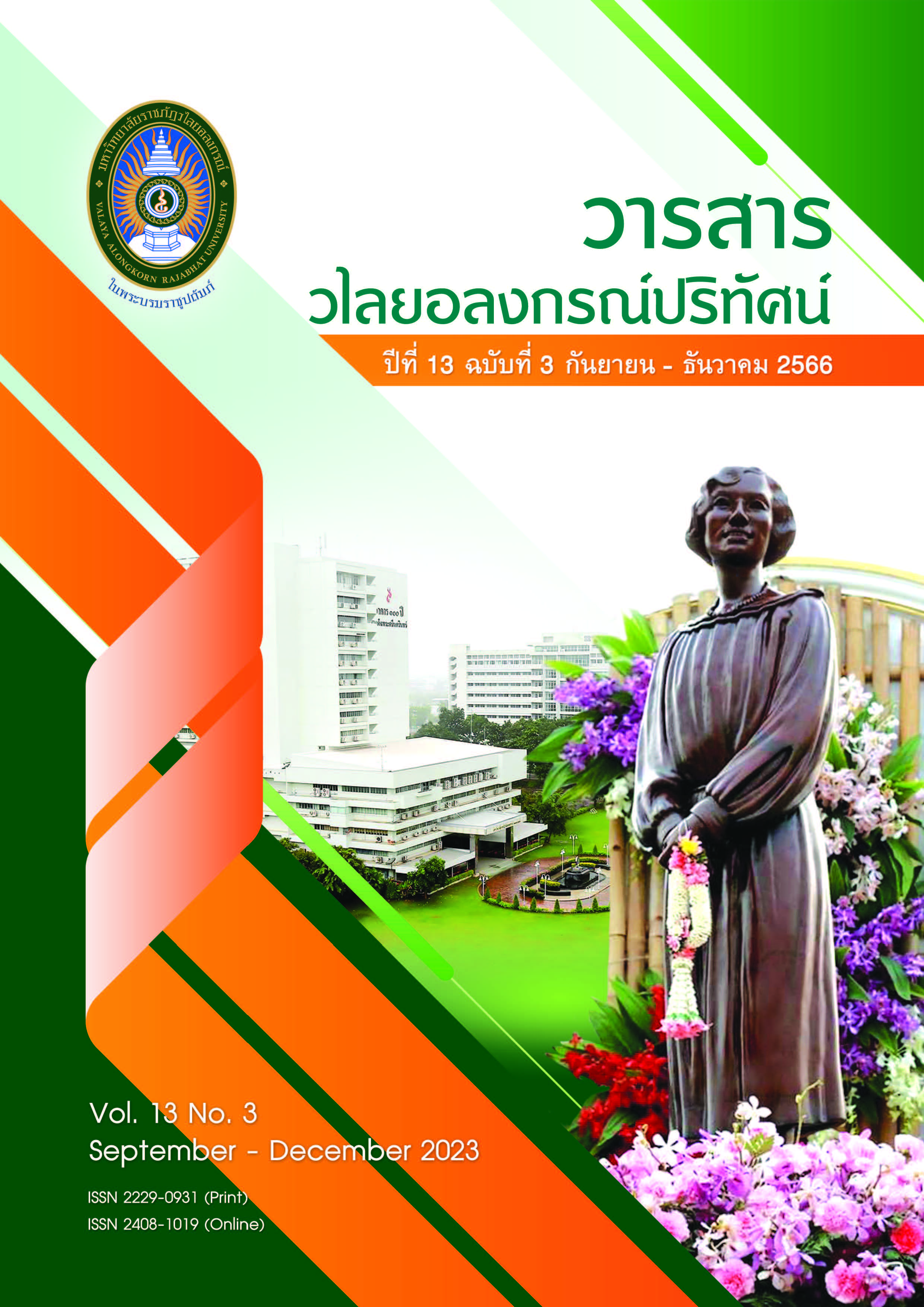ผลของการจัดกิจกรรมการเรียนรู้ภูมิศาสตร์ด้วยแนวคิดการเรียนรู้ โดยใช้ฉากทัศน์เป็นฐานที่ส่งผลต่อทักษะการสร้างแผนที่และทักษะการคิดเชิงพื้นที่ของนักเรียนมัธยมศึกษาตอนปลาย
คำสำคัญ:
ฉากทัศน์เป็นฐาน, ทักษะการสร้างแผนที่, ทักษะการคิดเชิงพื้นที่บทคัดย่อ
บทความวิจัยนี้มีวัตถุประสงค์ 1) เพื่อสร้างกิจกรรมการเรียนรู้ภูมิศาสตร์ด้วยแนวคิด การเรียนรู้โดยใช้ฉากทัศน์เป็นฐานที่ส่งผลต่อทักษะการสร้างแผนที่และทักษะการคิดเชิงพื้นที่ของนักเรียนมัธยมศึกษาตอนปลาย และ 2) เพื่อศึกษาประสิทธิผลของการจัดกิจกรรมการเรียนรู้ภูมิศาสตร์ด้วยแนวคิดการเรียนรู้โดยใช้ฉากทัศน์เป็นฐานที่ส่งผลต่อทักษะการสร้างแผนที่และทักษะการคิดเชิงพื้นที่ของนักเรียนมัธยมศึกษาตอนปลาย กลุ่มตัวอย่างการวิจัย คือ นักเรียนชั้นมัธยมศึกษาปีที่ 5 โรงเรียนวัดราชโอรส จำนวน 35 คน โดยใช้วิธีการสุ่มแบบกลุ่มตัวอย่าง เครื่องมือที่ใช้ คือ แผนการจัดการเรียนรู้กิจกรรมการเรียนรู้ภูมิศาสตร์ด้วยแนวคิดการเรียนรู้โดยใช้ฉากทัศน์ แบบวัดทักษะการสร้างแผนที่และทักษะการคิดเชิงพื้นที่แบบปรนัยและอัตนัยมีค่าดัชนีความสอดคล้อง อยู่ระหว่าง 0.67- 1.00 พบว่า มีค่าอำนาจจำแนกโดยใช้วิธีสหสัมพันธ์อย่างง่ายแบบเพียร์สัน โดยการหาค่าความสัมพันธ์ระหว่างคะแนนรายข้อกับคะแนนรวมอยู่ระหว่าง 0.35-0.85 และมีค่าความเชื่อมั่นของแบบสอบถามทั้งฉบับ โดยใช้สูตรสัมประสิทธิ์แอลฟาของครอนบราคที่ระดับ 0.885 ทำการวิเคราะห์ข้อมูลด้วยการหาค่าเฉลี่ย ส่วนเบี่ยงเบนมาตรฐาน และค่าความแปรปรวนของตัวแปรพหุนามแบบวัดซ้ำ
ผลการวิจัยพบว่า 1) การจัดกิจกรรมการเรียนรู้ภูมิศาสตร์ด้วยแนวคิดการเรียนรู้โดยใช้
ฉากทัศน์เป็นฐานมี 3 ขั้นตอน คือ (1) ขั้นการกำหนดปัญหา (2) ขั้นการมีส่วนร่วมในฉากทัศน์หรือสถานการณ์ และ (3) ขั้นการสะท้อนผลการเรียนรู้ 2) นักเรียนที่ได้รับการใช้จัดกิจกรรมการเรียนรู้ภูมิศาสตร์ด้วยแนวคิดการเรียนรู้โดยใช้ฉากทัศน์เป็นฐานที่ส่งผลต่อทักษะการสร้างแผนที่และทักษะการคิดเชิงพื้นที่ของนักเรียนมัธยมศึกษาตอนปลายเมื่อวิเคราะห์ความแปรปรวนของพหุนามแบบวัดซ้ำ พบว่า ทักษะการสร้างแผนที่และทักษะการคิดเชิงพื้นที่จากการวัดซ้ำ 6 ครั้ง พบว่า ทักษะการสร้างแผนที่และทักษะการคิดเชิงพื้นที่ของนักเรียน มีความแตกต่างกันอย่างมีนัยสำคัญทางสถิติ ที่ระดับ .05 (F (5,30) = 52.967, p < .001)
เอกสารอ้างอิง
กมลชนก สกนธวัฒน์. (2563). การพัฒนาชุดกิจกรรมการเรียนรู้ทางเศรษฐศาสตร์โดยใช้แนวคิดการเรียนรู้แบบฉากทัศน์เป็นฐานเพื่อส่งเสริมความฉลาดรู้การเงินของนักเรียนมัธยมศึกษาตอนต้น. วารสารศิลปากรศึกษาศาสตร์วิจัย. 12(2): 34-52.
สาวิตรี รตโนภาส สุวรรณลี. (2564). สถิติเชิงพื้นที่สำหรับนักภูมิศาสตร์ = Spatial Statistics for Geography. มหาสารคาม: ภาควิชาภูมิศาสตร์ คณะมนุษยศาสตร์และสังคมศาสตร์ มหาวิทยาลัยมหาสารคาม.
สำนักวิชาการและมาตรฐานการศึกษา. (2560). ตัวชี้วัดและสาระการเรียนรู้แกนกลางสาระภูมิศาสตร์ (ฉบับปรับปรุง พ.ศ. 2560) กลุ่มสาระการเรียนรู้สังคมศึกษา ศาสนา และวัฒนธรรม ตามหลักสูตรแกนกลางการศึกษาขั้นพื้นฐาน พุทธศักราช 2551 และแนวทางการจัดการเรียนรู้. กรุงเทพฯ: โรงพิมพ์ชุมนุมสหกรณ์การเกษตรแห่งประเทศไทย.
De Leon, L. (2015). Bots, Blogs, and Scenario-based e-Learning: A Discourse Analysis into Unintended Realities and Emotionality of Learning about Children.
The International Journal of Interdisciplinary Educational Studies. 10(2): 13-25.
Decki R. F. (2012). Analysis of Spatial Thinking Test in Geographical Space. Wageningen: Wageningen University and Research Centre.
Errington, E. (2011). Mission Possible: Using Near-World Scenarios to Prepare Graduates for the Professions. The International Journal of Teaching and Learning in Higher Education. 23(1): 84-91.
Howell, D. C. (2013). Statistical methods for psychology (8. utg.). Wadsworth: Cengage Learning.
Jo, I. (2010). Aspects of spatial thinking in geography textbook questions. Texas: Texas A&M University.
Jo, I., & Bednarz, S. W. (2009). Evaluating Geography Textbook Questions from a Spatial Perspective: Using Concepts of Space, Tools of Representation, and Cognitive Processes to Evaluate Spatiality. Journal of Geography. 108(1): 4-13.
Kerski, J. J. (2008). The role of GIS in Digital Earth education. International journal of digital earth. 1(4): 326-346.
National Research Council. (2005). Learning to think spatially. Washington DC: National Academies Press.
Nordhaus, W. D. (2006). Geography and macroeconomics: New data and new findings. Proceedings of the National Academy of Sciences. 103(10): 3510-3517.
Papadopoulos A. (2019). Integrating the Natural Environment in Social Work Education: Sustainability and Scenario-based Learning. Australian Social Work. 72(2): 233-241.
Sarah, W. B., Susan, H., & Niem, T. H. (2013). Road Map for 21st Century Geography Education Project. Washington DC: Association of American Geographers.
Schlemper, M. B., Stewart, V. C., Shetty, S., & Czajkowski, K. (2018). Including students’ geographies in geography education: Spatial narratives, citizen mapping, and social justice. Theory & Research in Social Education. 46(4): 603-641.
Scholz, M. A., Huynh, N. T., Brysch, C. P., & Scholz, R. W. (2014). An evaluation of university world geography textbook questions for components of spatial thinking. Journal of Geography. 113(5): 208-219.
Xiang, X., & Liu, Y. (2019). Exploring and enhancing spatial thinking skills: Learning differences of university students within a web-based GIS mapping environment. British Journal of Educational Technology. 50(4): 1865-1881.
ดาวน์โหลด
เผยแพร่แล้ว
รูปแบบการอ้างอิง
ฉบับ
ประเภทบทความ
สัญญาอนุญาต
ลิขสิทธิ์ (c) 2023 สุภชัย ปิ่นมณี, กัมปนาท บริบูรณ์, รุจน์ ฦาชา

อนุญาตภายใต้เงื่อนไข Creative Commons Attribution-NonCommercial-NoDerivatives 4.0 International License.
ข้อความที่ปรากฏในบทความแต่ละเรื่องในวารสารวไลยอลงกรณ์ปริทัศน์ เป็นความคิดเห็นของผู้นิพนธ์แต่ละท่าน มิใช่เป็นทัศนะและมิใช่ความรับผิดชอบของกองบรรณาธิการจัดทำวารสาร และ
มหาวิทยาลัยราชภัฏวไลยอลงกรณ์ ในพระบรมราชูปถัมภ์


